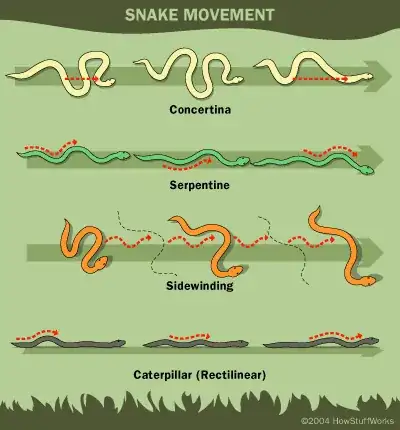The fastest, most efficient means of locomotion for a serpentine being is for it to roll itself into a hoop and roll around like a wheel. It can provide propulsive effort by flattening the loop slightly similar to a caterpillar track and flexing and extending its body in the appropriate way, or it can form a perfect circle and take advantage of inertia to keep it moving. It can steer by flexing its body from side to side, and could conceivably turn in little more than its own diameter.
It could be expected that on level ground, such a being using this method of locomotion could easily outpace and outdistance any creature using a method of locomotion that involves reciprocating limbs or any other variety of serpentine locomotion. It could conceivably keep pace with some slower or even medium-speed birds. A speed of 100kph sustained for over an hour or more is not inconceivable, but this would be approaching a maximum practical speed.
This is all well and good in theory, however there are also a few potential drawbacks:
A lamia's body, coiled into a ring, might be unbalanced. This could be overcome to some extent by overlapping the thinner end of the tail with the torso, and this would also protect the torso somewhat.
This would require that the ground be pretty smooth. Obstacles such as medium-sized rocks might cause injury if impacted at any speed. However, roads and herbivore-grazed plains would be ideal terrain. On rougher, less level terrain, the other forms of serpentine locomotion the OP mentioned would be required.
Balance might be an issue. If a lamia relies on anything like a human's system of semicircular canals in the inner ear, such rotation could cause dizziness. However, since several other species move in a manner at least similar to this, this is not an insurmountable problem.
It would be difficult for the lamia to see where it was going. It might need to put its head out of the loop to the side, or turn its torso so that it was looking over its shoulder. Either way, there would be a significant part of the rolling cycle in which the lamia could not be looking where it was going. It would need pretty good eyesight to be able to see obstacles a sufficient distance ahead, and it would also need fast eyes so that it could form clear images despite its rotation. This would lead to an increase in its flicker-fusion frequency, meaning that a lamia would likely see a human movie at a mere 25 FPS as being a series of static images.
The faster the lamia moves in this manner, the greater the centripetal forces attempting to pull its body out of its loop. Lamiae would likely need to evolve some sort of latching mechanism in order to keep their body in shape at higher speeds, or the lamiae may need to resort to artificial harnesses in order to overcome this limitation.
Still, despite all these limitations and problems, if they could be overcome, it would change lamiae from a slow, lumbering species with poor endurance to the fastest, longest-distance cursorial species the world has yet seen, humans included.

